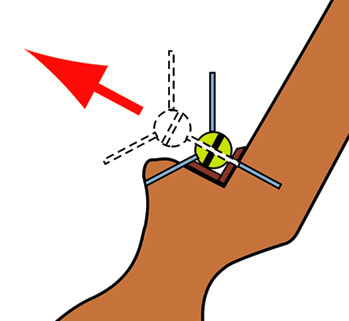 One other very important datum for the regulation of a bow, is represented by the point where the arrow touch the bow.
One other very important datum for the regulation of a bow, is represented by the point where the arrow touch the bow.
So we can set the support sticking some leather' s thickness on the lateral side of the window until we reach the point we want.
For the longbow this point is really far from the centre shoot and it doesn' t present particular problems of regulation, being these bows made purposely in this way.
Instead, for the recurves is very important to have the availability of an excellent regulation of this point.
We nock an arrow on the bow and, holding it in front of us we cast optically with an eyes the string on the middle of the flexors; to have an ideal point we should see the end of the arrow on the left side of the string as much as the thickness of the arrow (on the right side for the left-handed).
As regard to the inferior support of the arrow, this should be as near as possible to the hand, and the contact point as tight and receding as possible to not interfere with the exit of the arrow.
Using the bow inclined, this support can even be lightly oblique as much as would let the arrow to slide away with a straight bow and that make it easy for the arrow to exit in a perfect way during the release.
Whose that cant renounce to a straight bow should have to be satisfied of the best compromised that is possible to have.

The base of the window can be protect by the classic little synthetic carpet, by a simply piece of leather, or as I use, without any protection.(less elements-less possibilities of problems).
In the bows not expressly made for the instinctive shoot, the base of the window can be modify, searching to make it a bit more right.
Otherwise, or however in case of flight problems of the arrow on standard bows, often we obtain some improvements growing up the brace, raising the hooking and growing up the thickness of the lateral support.


Follow us